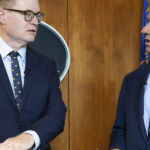The Federal Reserve (Fed) will enter its blackout period on April 26 ahead of its next policy meeting scheduled for May 6–7. Markets widely expect the Fed to keep rates unchanged, with the CME FedWatch Tool showing only about a 10% chance of a 25-basis-point hike. Meanwhile, the FXStreet (FXS) Fed Sentiment Index remains near 120, signaling that the Fed maintains a hawkish stance.
Earlier this month, speaking at the Economic Club of Chicago, Fed Chair Jerome Powell emphasized that the Fed is in a strong position to wait for clearer economic signals before adjusting policy. Addressing the potential inflationary impact of President Donald Trump’s new tariff regime, Powell remarked, “The inflationary effects of tariffs could be more persistent; it ultimately depends on inflation expectations.”
Echoing Powell’s caution, St. Louis Fed President Alberto Musalem noted that fighting inflation would become the top priority if inflation expectations were destabilized by tariffs. Similarly, Minneapolis Fed President Neel Kashkari stressed, “Our job at the Fed is to keep inflation under control so that interest rates don’t need to go even higher.”
Despite these affirmations of policy independence, the FXS Fed Sentiment Index continues to signal hawkishness even as threats to the Fed’s autonomy emerge.
Is Fed Independence Under Threat?
Even with a broadly hawkish tone from Fed officials and market expectations leaning toward a policy hold in May, the US Dollar (USD) has been losing ground against major currencies. The USD Index — which tracks the USD against six major rivals — has fallen nearly 6% in April, following a 3% decline in March. Analysts point to fears of a US economic slowdown, fueled by the Trump administration’s aggressive tariff measures, as the main reason behind the USD’s selloff.
Adding to the pressure are concerns about the Fed’s political independence.
On April 17, just before the European Central Bank’s policy announcement, President Trump criticized Fed Chair Powell on social media, calling him “too late and wrong.” Trump wrote, “The ECB is expected to cut interest rates for the 7th time, and yet, ‘Too Late’ Jerome Powell of the Fed, who is always too late and wrong, yesterday issued a report which was another, and typical, complete mess!”
The next day, White House economic adviser Kevin Hassett told reporters that the administration was actively exploring whether firing Powell was an option, suggesting a more aggressive stance than previously seen. This development triggered fresh selling pressure on the USD, pushing the USD Index to its lowest level in nearly three years, around 98.00.
Assessing the fallout, UBS economist Paul Donovan commented, “Investors seem less than happy with the idea of a politicized Fed—the US dollar and long-dated government bonds have weakened.” He also noted that although there are institutional checks on presidential authority—such as Senate confirmation for Fed governors—the effectiveness of these checks depends heavily on adherence to the rule of law.









